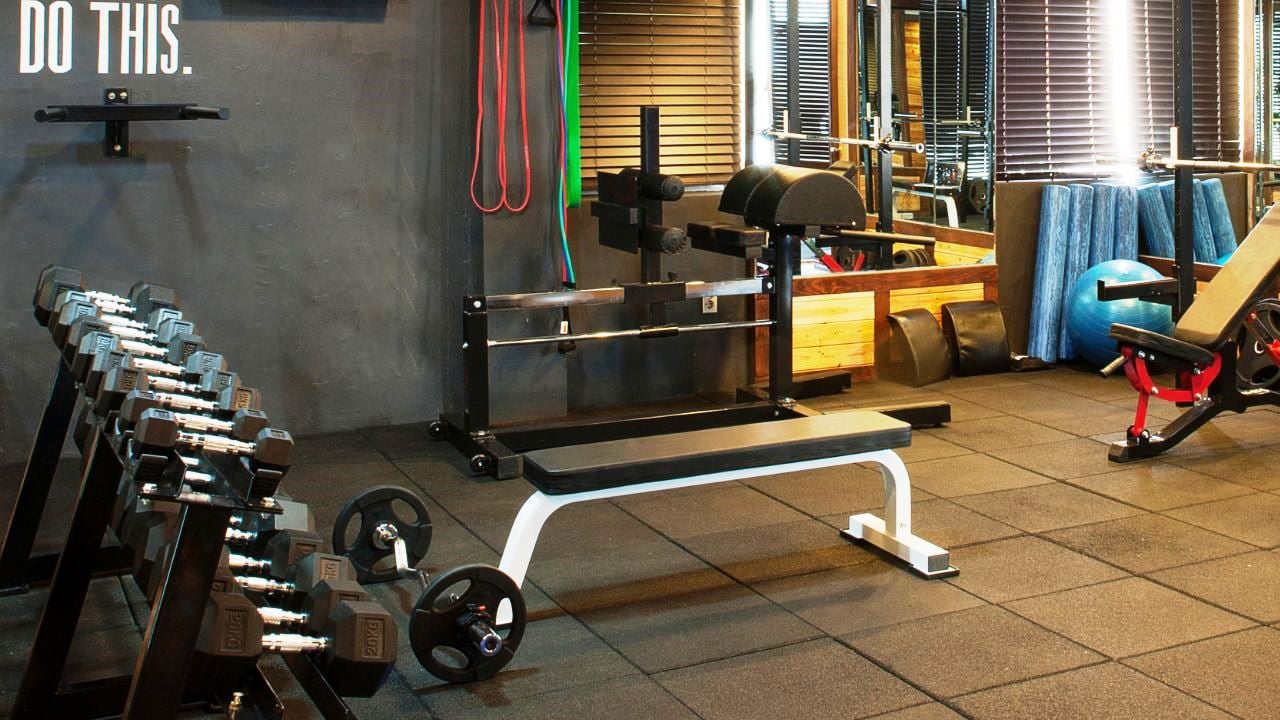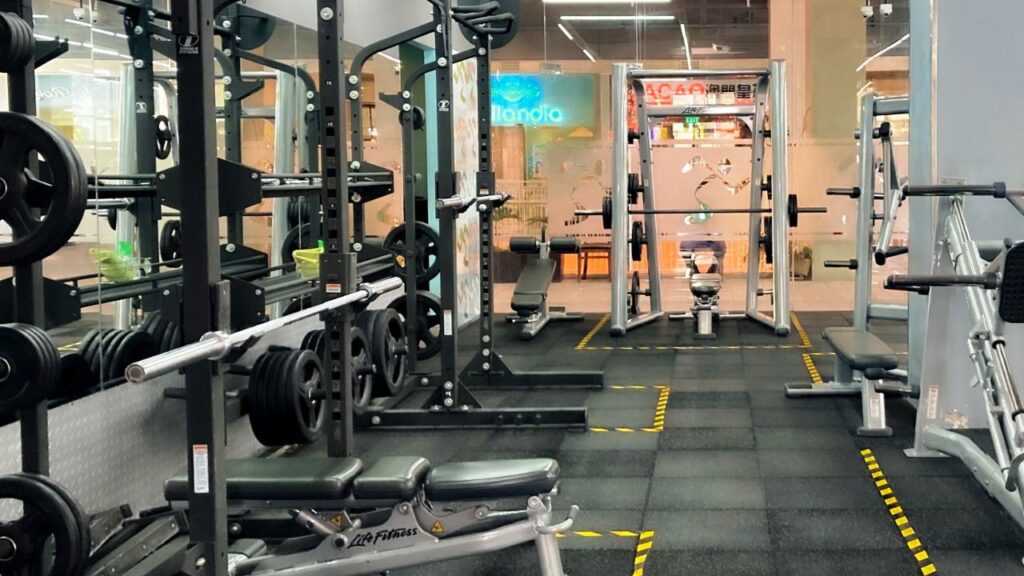Ugh, there they are again – abandoned weights scattered around the gym like fallen weapons on a battlefield.
We’ve all waded through a sea of dumbbells or dodged a barbell left carelessly in the middle of the floor. It’s not just annoying; it can be downright dangerous.
This may seem like simple standard tidiness, but it is actually quite important for saving time and energy for other gym users.
Re-racking your weights isn’t just some annoying gym rule dreamed up by fitness overlords. It’s a fundamental part of gym culture, a silent agreement between gym-goers to respect the space and each other.
Let’s take this opportunity to discuss the important topic of re-racking your weights with your gym buddy.

- Why Re-racking Weights Matters
- Safety: The #1 Priority
- Courtesy: Sharing is Caring
- Organization: Efficiency Wins
- Cleanliness: It’s about Hygiene
- Healthy Culture: Influence Others
- Proper Techniques For Re-racking Weight
- How To Re-Rack Gym Equipment
- Dumbbells: Match those weights
- Barbells: Plates, racks
- Kettlebells, Medicine Balls, & More
- Machines with Removable Weights
- Re-Rack Your Weights Quotes
- Conclusion
Why Re-racking Weights Matters
Changing weights is an essential aspect of gym etiquette and is essential for several reasons.
Safety: The #1 Priority
Leaving weights lying around the gym floor can create significant tripping hazards. Imagine stepping over a dumbbell mid-squat or changing your path because someone left a barbell out.
Unracked weights can cause injuries. Not only can weights fall on your toes, but you can also hurt yourself trying to move or unload someone else’s heavy equipment.
Courtesy: Sharing is Caring
No one likes playing hide-and-seek with the equipment they need. If someone leaves a 300-pound barbell loaded up, the next person has to waste their time and energy removing all those plates before they can even start their own set.
Re-racking weights is a simple gesture of respect for your fellow gym-goers.
Organization: Efficiency Wins
A well-organized, tidy gym makes for a smoother workout experience. When everything is in its place, you don’t waste time searching for what you need.
When weights aren’t arranged in a neat way, it makes gym time less enjoyable for everyone.
Cleanliness: It’s about Hygiene
Re-racking weights and wiping down benches after use are linked to basic gym hygiene.
Keeping the space organized and equipment clean contributes to a healthier environment, reducing the spread of sweat and germs.
Healthy Culture: Influence Others
Gyms are shared spaces. Not just keeping things tidy, it’s also showing that you care. Re-racking weights shows your commitment to making the gym experience better for everyone.
Your actions matter. When people see others doing good things at the gym, it can make them want to do the same. This creates a culture of respect and organization that helps everyone who goes there.
Want to take your gains to the next level? Discover your daily calorie needs with our free TDEE calculator
Proper Techniques For Re-racking Weight
Re-racking isn’t rocket science, but proper ways exist for efficiency and everyone’s safety. Make re-racking a seamless part of your workout routine with these best practices:
- Clear the Area and make sure there’s enough space around the rack to weight.
- Match dumbbells in pairs and ensure barbells have even weight distribution on both sides. Everything has a specific ‘home’ on the rack.
- Safety first, make sure you do things correctly. Bend your knees, tighten your core, lift with your legs, and ask for help when lifting heavy things. Prevent back injuries!
- Carefully set all weights back in their slots or on their pegs. Make sure everything is stable to prevent knocking things over.
- Weight plates can be placed on a weight plate rack stand or placed on the tree, varying in weight from heaviest to lightest.
- Put dumbbells back on the rack in order. Check they’re seated properly so they won’t roll off.
- Re-rack immediately after each set, not once you’re completely done. No one likes waiting for you to clear the bench!
- If something’s out of order, a polite heads-up to staff or another gym member helps keep things organized.
- If you’re using a shared bench or other equipment, put back the weights when you’re finished. Don’t make people wait for you to clean up.
- Your consistency shows good “gym citizenship.” Others notice, which can help improve the overall gym atmosphere for everyone.

How To Re-Rack Gym Equipment
Re-racking weights safely and correctly is as important as using them in the first place. Follow these guidelines:
Dumbbells: Match those weights
- The dumbbell racks usually have tiers marked with weight increments.
- Return dumbbells in pairs, placing them securely on the correct tier.
- Most gyms either go lightest to heaviest (bottom to top) or the reverse – observe and match your gym’s system.
Barbells: Plates, racks
- Barbell racks have slots for various weights. You should return unloaded barbells to the corresponding height or spot.
- Remove ALL weight plates. Return these to designated weight trees, sorting by size (this keeps everyone’s workouts running smoothly).
- Don’t forget collars/clips—secure them back onto the barbell or in their designated place.
Kettlebells, Medicine Balls, & More
- These usually have shelves or racks; return them to the proper area by weight/size.
- Don’t just pile them haphazardly; stack neatly so everything is easy to find.
Machines with Removable Weights
- Stack machines will have pins to indicate weight. Remove the pin entirely, ensure the plates are secure, and then carefully insert the pin back into the weight you were using.
- Some gym machines use removable attachments (like different bars on cable stations). Always return these to their specific holders.
Benches, mats, resistance bands, even those foam rollers…they all have a place they belong. Returning everything after use makes sure it’s there for the next person.
To Stay Motivated: 150+ Gym Workout Motivational Quotes To Stay Fit
Re-Rack Your Weights Quotes
- Re-racking weights is a sign of strength, not weakness.
- Be a gym hero, re-rack your weights!
- Progress starts with putting things back where they belong.
- Your workout isn’t over until those weights are re-racked.
- Respect the gym, respect yourself. Re-rack those weights.
- A tidy gym is a happy gym. Do your part.
- Re-racking builds discipline, inside and outside the gym.
- Leave the gym better than you found it. Always re-rack.
- Strong muscles AND strong gym etiquette.
- Don’t let laziness outweigh your gains.
- If you can lift it, you can put it back.
- Weights on the floor? That’s a new low, even for leg day.
- Re-racking weights: It’s easier than explaining why you didn’t.
- Cardio is hard, re-racking isn’t. Get it together.
- Don’t leave your gains (or your weights) lying around.
- If you love using the equipment, show it by putting it back.
- Ninjas re-rack their weights. Don’t be a weight-leaving bandit.
- Re-rack your weights. It’s the right thing to do.
- Gym etiquette 101: Always re-rack.
- Re-racking saves time and prevents injuries.
- Find it, use it, return it. Simple.
- A clean gym is a productive gym.
- Your weights shouldn’t take a vacation on the gym floor.
- Respect the space, re-rack your weights.
- Show off your manners, not just your muscles.
- Leave your ego at the door, re-rack your weights on the floor
Conclusion
Re-racking your weights seems like a small thing, but it has a big impact.
You’re not just taking care of yourself, you’re also making the gym a better place to workout, more respectful, and more productive for everyone.
So, here’s the challenge: always re-rack those weights, and don’t be shy about encouraging others to do the same.
Being polite and thoughtful can make a big difference. We can make our gyms places where everyone feels motivated, supported, and ready to reach their goals.

Manish is a NASM-certified fitness and nutrition coach with over 10 years of experience in weight lifting and fat loss fitness coaching. He specializes in gym-based training and has a lot of knowledge about exercise, lifting technique, biomechanics, and more.
Through “Fit Life Regime,” he generously shares the insights he’s gained over a decade in the field. His goal is to equip others with the knowledge to start their own fitness journey.
